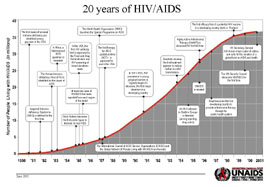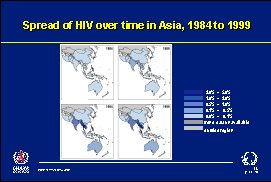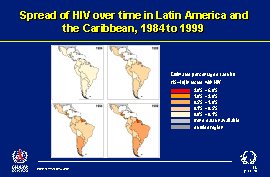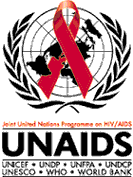Twenty years of
HIV/AIDS
In
June 1981, scientists in the United States reported the first
clinical evidence of a disease that would become known as Acquired
Immunodeficiency Syndrome or AIDS. Twenty years later, the AIDS
epidemic has spread to every corner of the world. Almost 22
million people have lost their lives to the disease and over
36 million people are today living with HIV, the virus that
causes AIDS. But two decades of struggle to control the epidemic
have also yielded a growing arsenal of breakthroughs.
Twenty
years of HIV/AIDS in graphics
- 1981
The first cases of
unusual immune system failures are identified among gay men in the
United States.
- 1982
Acquired Immunodeficiency Syndrome (AIDS) is defined
for the first time. In the course of the year, the three modes of
transmission are identified: blood transfusion, mother-to-child,
and sexual intercourse.
- 1983
The Human Immunodeficiency Virus (HIV) is identified as
the cause of AIDS. In Africa, a heterosexual AIDS epidemic is
revealed.
- 1985
The scope of the growing epidemic becomes manifest. By
1985, at least one case of HIV/AIDS has been reported in each
region of the world.
Film star Rock Hudson becomes the
first international icon to disclose he has AIDS.
In the
United States, the Food and Drug Administration (FDA) approves the
first HIV antibody test and HIV screening of blood donations
begins.
- 1987
Africa's first community-based response to AIDS (The
AIDS Support Organisation or TASO) is formed in Uganda. It becomes
a role model for similar activities around the world.
The
International Council of AIDS Service Organizations (ICASO) and
the Global Network of People living with HIV/AIDS are founded.
In February, the World Health Organization (WHO)
establishes the Special Programme on AIDS, later to become the
Global Programme on AIDS.
The first therapy for AIDS -
azidothymidine (AZT) - is approved for use in the United
States.
- 1988
In
London, health ministers from around the world meet for the first
time to discuss the HIV/AIDS epidemic.
- 1991-1993
HIV prevalence in young pregnant women
in Uganda begins to decrease - the first significant downturn in a
developing country. The success is attributed to countrywide
mobilization against the epidemic.
- 1994
Scientists develop the first treatment regimen to
reduce mother-to-child transmission.
- 1995
An HIV outbreak in Eastern Europe is detected among
injecting drug users.
- 1996
The Joint United Nations Programme on HIV/AIDS (UNAIDS)
is created.
Evidence of the efficacy of Highly Active
Antiretroviral Therapy (HAART) is presented for the first time.
- 1997
Brazil becomes the first developing country to provide
antiretroviral therapy through its public health system.
- 1998
The first
short-course regimen to prevent mother-to-child transmission is
announced.
- 1999
The first efficacy trial of a potential HIV vaccine in
a developing country starts in Thailand.
- 2000
The UN Security Council discusses HIV/AIDS for the
first time.
- 2001
UN Secretary-General Kofi Annan launches his call to
action, including the creation of a global fund on AIDS and
health.
Twenty years of
HIV/AIDS in graphics
 |
Time
chart showing major scientific and social milestones over the
past 20 years
|
 |
Spread
of HIV over time in sub-Saharan Africa, 1984 to
1999
|
 |
Spread
of HIV over time in Asia, 1984 to 1999
|
 |
Spread of HIV over time in Latin America, 1984 to
1999
|
|
